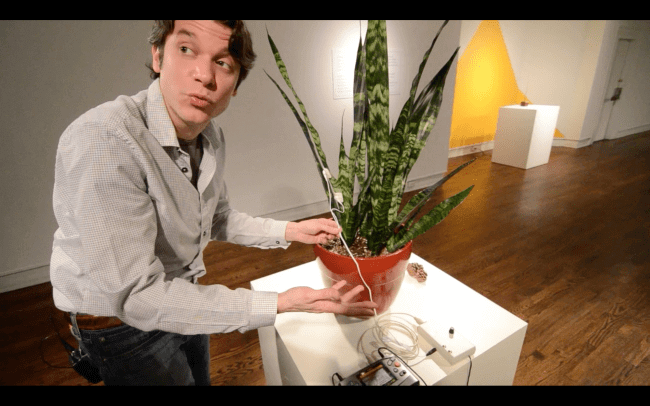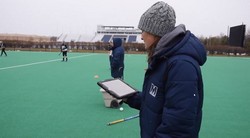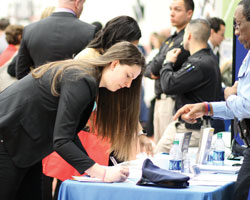Monmouth University’s ArtNOW visiting artist series hosted a virtual Arts-Engineering discussion and performance with Sam Cusumano on Monday, Nov 1.
The event was a continuation of this year’s theme, Electric Frequencies: Social Progress and Digital Activism. In the first installment of the two-part series, Cusumano discussed his recent work with biodata sonification on plants and fungi.
“It’s one of my projects that I’ve been working on for a number of years, where I connect electrodes to an organic system, in this case plants, and I use data to create musical notes,” explained Cusumano.
In this biodata sonification process, plants and fungi are connected with synthesizers to detect microcurrent fluctuations across the surface of a plant’s leaf and generate MIDI notes. Cusumano performed a live demonstration using a snake plant and pineapple top, playing the resulting sounds for the audience to hear.
“I am an audio musician using electronics. I use synthesizers, electronic hardware and software to create dynamic soundscapes. Understanding sound and different sound parameters allows me the ability to try to craft different frequencies that match up to changes that happen in a plant’s environment,” explained Cusumano. “When merged together, sometimes the results can be really pleasant. Sometimes they can also be really annoying. The plants here in my office are very active. They’re producing lots of changes and as they make those changes, I produce a musical note using MIDI.”
Cusumano compared his work with biodata sonification on plants to that of an EKG and a lie detector on humans, noting similarities in the ways that they detect changes in electrical conductivity.
Furthermore, Cusumano went on to discuss how plants and humans aren’t as different as some may think. “When we look at a plant, we often see something that is fairly static and unmoving. In reality, plants are extremely active and dynamic organisms,” said Cusumano. “In my system, I try to detect these microcurrent fluctuations using the leaf of the plant, which is where a lot of this activity happens. It’s very analogous to the human skin. Humans of course are in control of many of our actions, but it doesn’t take much to make someone blush, and then their skin and capillaries fill with blood. When we experience these types of occurrences, the electrical conductivity across the surface of our skin increases.”
“By taking complex data and using sound to represent changes and fluctuations that are happening in that data, I produce this music to represent what’s going on inside of the plant itself,” said Cusumano. “I tried to use sound as a way of taking extremely complex information, information that’s scrolling across a screen faster than your eyes could potentially see it.”
Cusumano described the process that went into making his biodata sonification device, explaining changes he made to a basic 555 Timer IC to alter its flash rate to indicate small changes in electrical conductivity. One electrode is used to send a small electric current through the leaf, and a second electrode that picks up this signal as it passes through.
Changes in microcurrent fluctuations across the leaf’s surface are used to generate MIDI notes which can be played through a synthesizer or computer to create sound.
“I wouldn’t necessarily call this music per se,” explained Cusumano. “I prefer something that’s a little bit more raw and accurately represents the changes that are happening. The notes are less important in this system than the timing of the notes as a change happens in the plant’s system.”
“One of my favorite aspects of biodata is when a human does not get involved at all, when a person simply waits and witnesses what’s happening,” he continued.
“It’s not just the sounds that people get out of this,” said Cusumano. “There is a lot that people bring internally in this process as they take time to sit and listen and watch. We started with talking about pretty plant music, and now we’re over to the epistemological nature of belief and how we perceive systems and how we can judge how intelligent or reactive a system or an organism is.”
“I do not know what the plants perceive, but I do have a system now that helps us hear that there is activity going on and there are changes. When you take time to sit and watch an environment and listen, sometimes we can pick up on what changes have occurred and feed that back into our own experience to understand what the plant itself is perceiving,” he concluded.
Sam Cusumano will return for a second installment of his visiting artist discussion on Monday, Nov. 8, where he will host a workshop in the IDM Research Lab to further explore biodata sonification.




